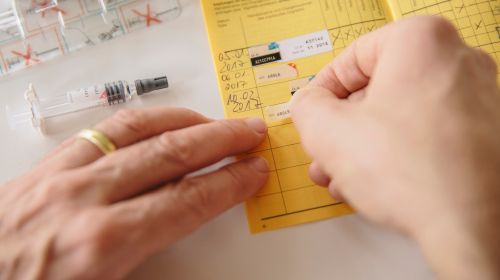Splenomegaly refers to a greatly enlarged spleen, which can occur as an accompanying symptom of various diseases. If the underlying disease is treated, the spleen usually shrinks again.
- © Getty Images/Westend61
Quick overview: Frequently asked questions and answers
Is splenomegaly dangerous? Splenomegaly is not usually dangerous, but it can be a symptom of a serious medical condition that should be treated.
In which diseases is the spleen enlarged? An enlarged spleen can occur in connection with many different diseases, including Pfeiffer’s glandular fever, liver cirrhosis, leukemia or lymphoma.
What to do about splenomegaly? The most important step is the medical examination. An enlarged spleen usually indicates an illness that requires treatment.
How long does it take for the spleen to become smaller again? It is hardly possible to give an exact time. The prognosis depends on what underlying disease is present and how well it can be treated.
Article contents at a glance:
What is Splenomegaly?
Splenomegaly is the medical term for a severely enlarged spleen. It is not an independent disease, but a symptom of another underlying disease.
The spleen is part of the lymphatic system, is located in the left upper abdomen and borders the stomach. The organ’s tasks include the production of immune cells (lymphocytes), filtering the blood and storing blood cells.
Splenomegaly: Symptoms of an enlarged spleen
Symptoms of splenomegaly can vary depending on the cause. Spleen enlargement may not cause any problems. Then it is discovered by chance during an ultrasound examination.
However, the enlarged spleen often manifests itself as pain or pressure in the upper left abdomen. This may be felt as a dull or pressing pain located below the left ribs.
Other symptoms include:
Due to the enlarged spleen, there may also be a feeling of pressure or fullness in the stomach. Those affected especially notice this after eating larger meals.
Causes of splenomegaly
Splenomegaly can be caused by various diseases. A temporary enlargement of the spleen can occur, especially with some infectious diseases. These include:
Congestion disorders and liver diseases
Certain liver diseases or disruption of blood flow in the portal vein can affect the spleen and cause it to enlarge. These include, among others:
- fatty liver
- chronic hepatitis
- Cirrhosis of the liver
- Budd-Chiari syndrome
- Portal vein thrombosis
Blood diseases
In certain hereditary blood diseases, the shape of the red blood cells (erythrocytes) is changed. As the spleen breaks down damaged blood cells, it has to process an increased amount of abnormally shaped red blood cells as a result of these diseases and enlarges. This includes:
Malignant diseases and cancer
The spleen plays a crucial role in the development of immune cells called lymphocytes. For this reason, splenomegaly is a common symptom associated with diseases in which white blood cells or lymphocytes proliferate uncontrollably, such as:
Tumors that arise primarily in the spleen are very rare. However, in some types of cancer such as colon cancer or breast cancer, metastases can form in the spleen and promote enlargement. However, this type of splenomegaly usually only occurs in the advanced stages of cancer.
Storage diseases
In some diseases, undigested substances can build up in cells and lead to a variety of problems, such as organ enlargement. Storage diseases that cause enlargement of the spleen include:
- Gaucher disease
- Tay-Sachs disease
- Niemann-Pick disease
- Fabry disease
Immune system diseases
Some immune system diseases are associated with splenomegaly because the spleen plays a crucial role in the immune system. This includes:
Other but rare causes of splenomegaly include injuries and accidents that can lead to bleeding or swelling of the spleen. In such cases, spleen enlargement is temporary and associated with trauma.
Hypersplenism: Complications resulting from an enlarged spleen
A so-called hypersplenism can occur as a complication of splenomegaly. This is an excessive activity of the spleen, in which it breaks down healthy blood cells to a large extent. This results in a reduced number of blood cells in the bloodstream. The consequences include anemia (anemia) due to a lack of red blood cells, increased susceptibility to infections due to a lack of white blood cells and an increased tendency to bleed due to too few platelets.
Symptoms of hypersplenism may include fatigue, weakness, increased infections, pallor, bleeding, and bruising.
Another complication is rupture of the spleen. Enlargement of the spleen can overstretch the organ and weaken the capsule that surrounds it. This makes the spleen more susceptible to rupture, even with minimal or no force.
Diagnosis: This is how an enlarged spleen is examined
If symptoms such as a feeling of pressure in the left upper abdomen, a feeling of fullness, early feeling of satiety or sudden severe pain without signs of illness occur, patients should visit their family doctor’s office.
If an enlarged spleen is suspected, the doctor can usually feel it below the left costal arch. In addition, spleen enlargement can be easily diagnosed with an ultrasound examination. If necessary, computer tomography (CT) or magnetic resonance imaging (MRI) may also be necessary as part of the examination. In addition, if splenomegaly is suspected, blood values are examined because those affected often have fewer red and white blood cells or platelets.
If an underlying cancer is suspected, it may be necessary to examine the spleen tissue. For an accurate diagnosis, a tissue sample from the spleen is then taken using a biopsy.
Treatment of splenomegaly
Since splenomegaly is often a result of other diseases such as infections, liver diseases, blood diseases or immune disorders, therapy initially focuses on treating these. If the underlying disease can be treated successfully, the enlargement of the spleen usually resolves again.
If symptoms such as pain, fatigue or increased susceptibility to infections also occur, these can be alleviated with medication to relieve pain or strengthen the immune system.
Hypersplenism is initially treated with blood transfusions to increase the proportion of blood cells. If therapy does not eliminate the hyperfunction, removal of the spleen (splenectomy) may be an option. This is possible because the spleen is not a vital organ and other organs can take over their defensive function in the immune system. However, those affected should protect their immune system with vaccinations following the operation.


